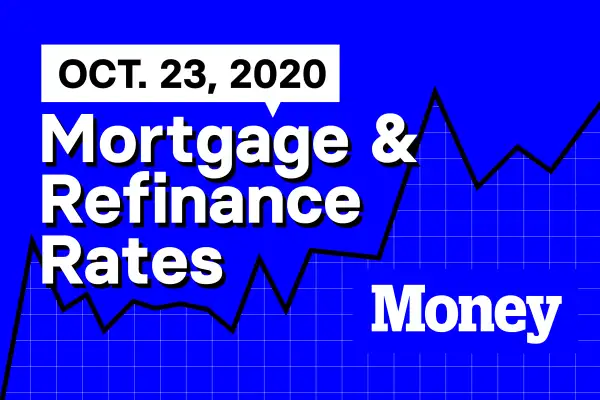Here Are Today's Best Mortgage & Refinance Rates for October 23, 2020

The average rate for a 30-year fixed-rate purchase mortgage was 3.576% on Thursday. The average rate for a 30-year refinance was 4.335%.
Money's current mortgage rates include data from over 8,000 lenders across the United States and are updated daily. These rates include discount points and represent what a borrower with a 20% down payment and 700 credit scores — roughly the national average FICO score — would have been quoted.
| 30-year fixed-rate purchase mortgage |
| 3.576% |
| Rate of October 22, 2020 |
Mortgage rates vary from state to state. On Thursday, borrowers in Illinois were quoted the lowest mortgage rates — at 3.367%. People looking for mortgages in Nevada saw the highest average rate at 3.817%. Nationwide, borrowers with the highest credit scores, 740 and above, were quoted rates averaging 3.082%, while those with credit of 640 or below were shown rates of 4.755% — a 1.673 percentage-point spread.
You may be able to negotiate a lower rate if you shop around or if you have other accounts with the lender. (Money's picks for the best mortgage lenders are here.) Currently, some banks are hiking up advertised rates to keep demand in check, so you may be offered a lower rate if you reach out directly.
Freddie Mac's widely quoted Primary Mortgage Market Survey put rates at 2.80% with 0.6 points paid for the week ending October 22, a new record low. The mortgage purchaser's weekly survey reflects borrowers who put 20% down on conforming loans and have excellent credit.
Refinance rates today
Money's survey also shows that the offered rate for a 30-year refinance for someone with a 740 credit score was 3.758% on Thursday. Last October, the average mortgage rate (including fees) was 3.859%.
| 30-year fixed-rate mortgage refi |
| 3.758% |
| Rate of October 22, 2020 |
A homeowner with a $200,000 mortgage balance currently paying 3.859% on a 30-year could potentially cut their monthly payment from $939 to $927 by financing at the current lower rates. To determine if it's worth it to refinance your mortgage, also consider the closing fees you paid on your current mortgage, how much your new lender is charging and how long you have left on your loan term. (Our picks for the best lenders for refinancing are here).
What else is happening in the housing market right now?
Existing-home sales continued a four-month streak of gains in September, increasing to a seasonally adjusted 6.54 million units, according to the National Association of Realtors. That represents a 9.4% increase over August and a whopping 21% increase from the same time a year ago when sales reached an annual rate of 5.41 million units. The figure includes single-family homes, condos, townhomes, and co-ops.
"Home sales traditionally taper off toward the end of the year, but in September they surged beyond what we normally see during this season," said Lawrence Yun, NAR's chief economist. "I would attribute this jump to record-low interest rates and an abundance of buyers in the marketplace, including buyers of vacation homes given the greater flexibility to work from home."
The median price for existing homes of all types was $311,800, up from last September's $271,500, an increase of nearly 15%. Prices across the nation have increased for the past 103 months.
Inventory took a big hit, down at an annual rate of 1.47 million units at the end of September. The current supply of homes stands at 2.7-months. That's down from August's 3-month supply and almost half of the 4-month supply available in September 2019. Fortunately, new home construction has picked up in recent weeks, which may help alleviate the shortage somewhat starting next year.
While the numbers for September look really good, much of that is due to the unusual pandemic-related housing market and seasonal adjustments.
"Seasonal adjustments are having an unusual effect on these numbers. Sales that would have occurred earlier in the year are happening now but having the historical seasonal adjustments applied," said Tendayi Kapfidze, chief economist with online mortgage marketplace LendingTree. "Actual sales of existing homes fell from August and the reported increase is entirely due to seasonal adjustments."
While mortgage rates remain at record lows, providing those who are still employed or have regained their jobs an opportunity to either purchase their first home or move into more spacious and socially distant houses, unemployment is still affecting a large number of people who won't be able to take advantage of the current housing market.
"It's a tale of two economies. Higher-income groups are doing far better than lower-income groups. Existing-home sales were at a 14-year high but the details are informative. Homes under $100,000 were down 16.3%, from $100,000 to $250,000 up 4.3%, but homes over $1 million were up 106.5%. This change in the mix of home is a driver of the jump in prices," added Kapfidze.
Bottom line:
Savvy Homebuyers Are Using an Under-the-Radar Strategy to Win Bidding Wars in 2020
New Construction Home Sales Are Soaring, but Financing a Purchase Can Be Tricky
Rates are subject to change. All information provided here is accurate as of the publish date.

